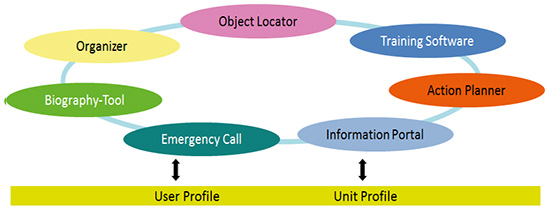Web-based Services for Older People And Caregivers


The research project WebDA aimed at supporting older users in the region Bonn-Rhine-Sieg to live at home independently as long as possible also when their memory skills decline. For that purpose, several services were developed, targeted at the different needs, ranging from users with mild cognitive impairments (MCI) up until users with moderate dementia. Advanced web services were created to improve memory performance, to provide structure to peoples’ everyday life, to counteract restlessness and to help to maintain social participation through training of communication skills. Since people affected by dementia often rely on the support of relatives as caregivers, WebDA also provides services that assist them in fulfilling their caring tasks.
For the WebDA services, advanced technologies in the area of Web of Things were implemented. The services can adapt to the users' preferences by employing semantic-based user and device profiles.
The concept of WebDA covers with its services the needs of users with a range of memory impairments, thus several prototypes of services were developed as described below. The focus of our team was to develop the Object Locator and the Action Planner.
The Object Locator service is intended to allow users with dementia to locate lost objects in their homes autonomously. For localization purposes, RFID-technology was employed. As input device the Object Locator uses a tablet. Its user interface is particularly designed to meet the requirements of users with dementia by composing a stimulus-reduced user interface with as few buttons as possible on the screen and by providing prompts to elicit proper user action for the navigation of the service. The multimodal user interface also supports the attention focussing process of users, as these skills typically decline in people afflicted with dementia. Additionally, the Object Locator can be accessed remotely, enabling caregivers to search for lost objects from their homes, either by themselves or together with their relatives.
The Action Planner aims at supporting caregivers of people afflicted with more severe forms of dementia. With the Action Planner, caring relatives can define actions with a rule editor to create context-aware reminders for daily living activities such as drinking water on a regular basis. For this purpose, not only time frames but also the location of a user can be specified, thus it could be defined that a reminder to drink shall only be triggered in case a user is located near the living-room table where the glass of water is placed. Besides this, event-triggered rules can be created, e.g., an SMS shall be sent to a caregiver in case restlessness is detected by constant wandering of a person between her bed and the chest of drawers in the sleeping room during the night. To allow the runtime evaluation of time- and location-aware rules, the Action Planner includes an RFID-based tracking system to locate a person in her home environment.
User studies in WebDA have shown that to allow caregivers to create easily rules, a user interface allowing them to express rules by a controlled natural language is the most feasible approach. Rule expressions are offered in preformulated natural sentences that can be manipulated by changing (pre)selected notions as “daily” in pop-up menus embedded in sentences. As immediate feedback on the impact of a user's choice, a rule summary is always provided on the top right side of the rule editor displaying the entire content of the selections (see screenshot below).
To keep sentences with rule definitions as simple as possible, a rule of the Action Planner consists of the components: intended action ("what"), time frame (“when”) and location setting ("where"). Editing these components was split in tabs to avoid visual clutter. For caregivers with little computer literacy a wizard feature was additionally developed to define rules providing step-by-step guidance during the rule editing process. It can always be switched back and forth between the standard and the wizard view.